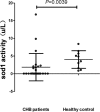Altered serum copper homeostasis suggests higher oxidative stress and lower antioxidant capability in patients with chronic hepatitis B
- PMID: 29901643
- PMCID: PMC6023651
- DOI: 10.1097/MD.0000000000011137
Altered serum copper homeostasis suggests higher oxidative stress and lower antioxidant capability in patients with chronic hepatitis B
Abstract
Copper homeostasis can be altered by inflammation. This study aimed to investigate the alteration of serum copper homeostasis and to explore its clinical significance in patients with chronic hepatitis B (CHB).Thirty-two patients with CHB and 10 aged- and sex-matched healthy controls were recruited. Analyses included serum levels of total copper (TCu), copper ions (Cu), small molecule copper (SMC), ceruloplasmin (CP), Cu/Zn superoxide dismutase 1 (SOD1), urinary copper, and the activities of serum CP and SOD1.The serum TCu and urinary copper levels in patients with CHB were significantly higher than the controls (P = .04 and .003), while the serum Cu was lower than the controls (P = .0002). CP and SOD1 activities in the serum were significantly lower in patients with CHB compared to controls (P = .005) despite higher serum concentrations. In addition, serum alanine aminotransferase inversely correlated with serum CP activity (P = .0318, r = -0.4065).Serum copper homeostasis was altered in this cohort of patients with CHB. The results suggest increased oxidative stress and impaired antioxidant capability in patients with CHB, in addition to necroinflammation. These results may provide novel insights into the diagnosis and treatment of patients with CHB.
Conflict of interest statement
The authors have no conflicts of interest to disclose.
Figures








Similar articles
-
Serum Copper Homeostasis in Hypertensive Intracerebral Hemorrhage and its Clinical Significance.Biol Trace Elem Res. 2018 Sep;185(1):56-62. doi: 10.1007/s12011-017-1227-4. Epub 2018 Jan 11. Biol Trace Elem Res. 2018. PMID: 29322430
-
The Alterations of Copper and Zinc Homeostasis in Acute Appendicitis and the Clinical Significance.Biol Trace Elem Res. 2019 Dec;192(2):116-122. doi: 10.1007/s12011-019-01661-2. Epub 2019 Feb 15. Biol Trace Elem Res. 2019. PMID: 30771140
-
Copper and zinc concentrations and the activities of ceruloplasmin and superoxide dismutase in atherosclerosis obliterans.Biol Trace Elem Res. 2000 Jan;73(1):55-65. doi: 10.1385/BTER:73:1:55. Biol Trace Elem Res. 2000. PMID: 10949969
-
Copper, ceruloplasmin and superoxide dismutase (SOD1) in patients with Down's syndrome.Pharmacol Toxicol. 2001 Dec;89(6):320-5. doi: 10.1034/j.1600-0773.2001.d01-168.x. Pharmacol Toxicol. 2001. PMID: 11903959 Clinical Trial.
-
Case-control studies on ceruloplasmin and superoxide dismutase (SOD1) in neurodegenerative diseases: a short review.J Neurol Sci. 2010 Dec 15;299(1-2):51-4. doi: 10.1016/j.jns.2010.08.047. Epub 2010 Sep 18. J Neurol Sci. 2010. PMID: 20851426 Review.
Cited by
-
Determination of copper poisoning in Wilson's disease using laser ablation inductively coupled plasma mass spectrometry.Ann Transl Med. 2019 Apr;7(Suppl 2):S72. doi: 10.21037/atm.2018.10.67. Ann Transl Med. 2019. PMID: 31179309 Free PMC article. Review.
-
Serum Levels of Zinc, Copper and Ferritin in Patients with Salivary Gland Tumors.Asian Pac J Cancer Prev. 2019 Feb 26;20(2):545-548. doi: 10.31557/APJCP.2019.20.2.545. Asian Pac J Cancer Prev. 2019. PMID: 30803218 Free PMC article.
-
Signaling Induced by Chronic Viral Hepatitis: Dependence and Consequences.Int J Mol Sci. 2022 Mar 3;23(5):2787. doi: 10.3390/ijms23052787. Int J Mol Sci. 2022. PMID: 35269929 Free PMC article. Review.
-
Mechanisms of copper metabolism and cuproptosis: implications for liver diseases.Front Immunol. 2025 Jul 30;16:1633711. doi: 10.3389/fimmu.2025.1633711. eCollection 2025. Front Immunol. 2025. PMID: 40808953 Free PMC article. Review.
-
Oxidative Stress in Chronic Hepatitis B-An Update.Microorganisms. 2022 Jun 21;10(7):1265. doi: 10.3390/microorganisms10071265. Microorganisms. 2022. PMID: 35888983 Free PMC article. Review.
References
-
- Das A, Maini MK. Innate and adaptive immune responses in hepatitis B virus infection. Dig Dis 2010;28:126–32. - PubMed
-
- Merican I, Guan R, Amarapuka D, et al. Chronic hepatitis B virus infection in Asian countries. J Gastroenterol Hepatol 2000;15:1356–61. - PubMed
-
- Darvesh AS, Bishayee A. Selenium in the prevention and treatment of hepatocellular carcinoma. Anticancer Agents Med Chem 2010;10:338–45. - PubMed
-
- Florescu L, Popa G, Balanica G, et al. Zinc--essential micronutrient for child health and nutrition. Rev Med Chir Soc Med Nat Iasi 2009;113:650–5. - PubMed
Publication types
MeSH terms
Substances
LinkOut - more resources
Full Text Sources
Other Literature Sources
Medical
Miscellaneous

